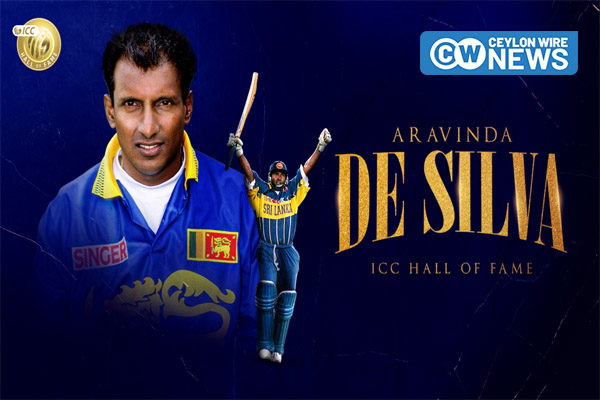Sri Lanka superstar Aravinda de Silva is among the three new additions to the ICC Hall Of Fame.
The International Cricket Council on Monday (13) announced the three new additions to the ICC Hall Of Fame.
1. Sri Lanka superstar Aravinda de Silva
2. Indian opener Virender Sehwag
3. India trailblazer Diana Edulji
The diminutive de Silva played a key role in Sri Lanka’s rapid rise from an emerging side to a powerhouse of the white-ball formats during an international career that spanned 19 years.
De Silva amassed a total of 15,645 runs for Sri Lanka across 93 C and 308 ODIs, and captained the team for several years in both formats.
The right-armer was also a cunning off-spinner and claimed 135 wickets at the elite level.
Pivotal performance leads to ultimate success
De Silva was crucial to Sri Lanka clinching their first-ever Cricket World Cup trophy in a stunning display with both bat and ball in the 1996 final.
The then 29-year-old picked up the important wickets of Australia captain Mark Taylor, rising star Ricky Ponting and keeper Ian Healy to finish with 3/42 in the first innings total of 241/7.
De Silva then became the first – and still the only – player to take three scalps and score a century in a men’s Cricket World Cup final as he steered Sri Lanka to their target with seven wickets remaining.
The right-hander arrived at the crease with Sri Lanka on the ropes at 23/2 then compiled a classy 107* from 124 balls with 13 boundaries to seal the rousing triumph and Player of the Match award.
Young gun quickly makes his mark
De Silva made his international debut as an 18-year-old at a time when Sri Lanka were still aiming to make their mark in Tests and ODIs.
Sri Lanka secured a rare victory in de Silva’s first ODI – then only the side’s fifth-ever win in the format – when they held off New Zealand by 41 runs in Moratuwa in March 1984.
De Silva would go on to become one of the great entertainers in the format with an assertive approach to batting that pulled together 9284 runs at an average of 34.9 with 11 tons and 64 fifties.
But it is de Silva’s strike rate of 81.13 in 308 ODIs that stands out among his contemporaries for an ability to score quickly or anchor an innings as the scenario required.
A pulsating 145 was de Silva’s highest individual score in ODIs and also came during the 1996 World Cup.
De Silva clubbed that century against Kenya while only facing 115 balls in the innings that was crucial to Sri Lanka topping their group with five wins from five matches on the way to the title.
A total of 448 runs for de Silva was the third most across the tournament, coming in only six innings at an average of 89.6 and during a dominant period for the Sri Lanka star.
De Silva would retire from ODIs at the end of the ICC Men’s Cricket World Cup 2003.
The stalwart amassed 267 runs for the third-most for Sri Lanka at the tournament but could not prevent them being knocked out in a semi-final against eventual champions Australia.
The off-spinner also claimed 106 scalps in ODIs at an average of 39.4 with two four-wicket hauls.

Sri Lanka overcome testing times
De Silva played England at Lords in his first Test in August 1984, in a match that petered out to a draw but revealed signs of what was to come.
Sri Lanka secured their historic first-ever Test victory soon after with a 149-run triumph over India in Colombo in September 1985.
Young gun de Silva fired when the match was on the line, scoring 75 in the second innings of just his third Test to help set India a target of 348 that proved to be well out of their reach.
The 1-0 result from three Tests was also Sri Lanka’s first series triumph in the format and their last until late 1992.
A maiden Test century would be secured shortly after in a patient 122 against Pakistan in Faisalabad in October 1985.
De Silva’s highest Test score of 267 was amassed against New Zealand in Wellington in January 1991.
The imperious innings came from 380 balls and with an incredible 40 fours and looked likely to lead to a victory until some stoic defence from the hosts.
De Silva later became the first batter to score a pair of unbeaten hundreds in a men’s Test, setting the milestone against Pakistan in Colombo in April 1997.
The 138* and 103* notched in that match were the second and third of de Silva’s six Test hundreds in six consecutive innings played on home turf – all of them on various grounds in Colombo.
It was farewell to remember when de Silva played his last Test against Bangladesh in Colombo in July 2002.
The then 36-year-old blasted 206 from 234 balls in his only innings of the match to leave the red-ball format on the highest of highs.
De Silva finished with 6391 runs at an average of 42.97 with 20 hundreds and 22 half-centuries in 93 Tests.
The 15,645 runs that de Silva scored across Tests and ODIs remains the fifth-most for a Sri Lanka batter in all formats combined.
Passing wisdom to the next generation
De Silva would not be lost to Sri Lanka cricket even after retiring from playing at the top level.
He held several positions among Sri Lanka selectors, including as chair of the national selection committee ahead of the ICC Men’s Cricket World Cup 2011 and again before the ICC Men’s T20 World Cup in 2016.









